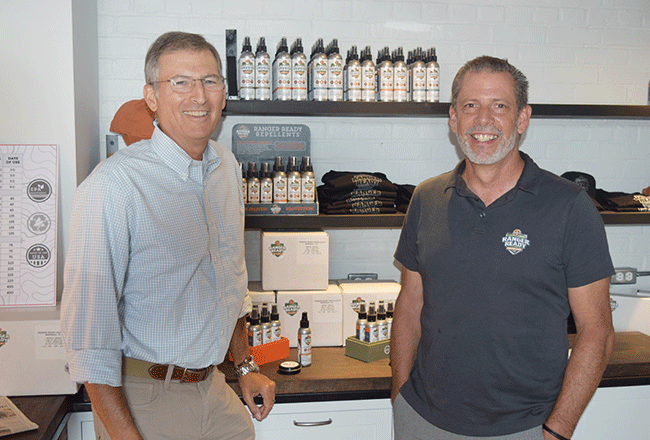
“Every week in this country, 5,000 people get a tick-borne disease and about 1,000 a week will have long-term effects and disabilities from those diseases,” observed Chris L. Fuentes. “We are literally the epicenter of tick-borne diseases and there has to be a way to stop it.”
Fuentes and his business partner Ted Kesten believe they might be on the right track to reversing this crisis. As the founders of Norwalk-based startup The Pic20 Group LLC, they are the driving force behind the new Ranger Ready Repellent line of tick and mosquito sprays. And with rising levels of tick infestation coupled with a return of mosquito-borne West Nile disease reports, the entrepreneurs are ready to take aim at a problem that has shown no signs of abating.
“There has been a billion dollars spent on repellents, but the disease level is not going down,” Kesten said. “The disease level is going up.”
Part of the problem, Kesten noted, was the growing level of consumer agitation with DEET, also known as diethyltoluamide, the most common active ingredient in insect repellents sold in the U.S. Kesten said that most people spray DEET in an overly cautious manner to avoid staining clothing or absorbing too much of the chemical through topical applications. “It is not being used correctly because of an irrational relationship with the product that you don”™t want to put on your skin,” he said.
Instead, the Ranger Ready Repellent line avoids DEET and uses picaridin, a compound that is more prevalent in European insect sprays. “It is one of the five active ingredients that the Centers for Disease Control recommends in the United States,” Fuentes said. “We recognized that picaridin was a better alternative to DEET, that naturals don”™t work and being able to put a product on your skin that was not harmful to you was a reason that Europeans have a lower level of tick-borne diseases.”
According to the National Pesticide Information Center, picaridin is a synthetic compound that was first made in the 1980s. “It was made to resemble the natural compound piperine, which is found in the group of plants that are used to produce black pepper,” according to the organization.
Fuentes, whose background was in marketing, teamed with Kesten, who came from a chemistry background developing fragrances and flavors, to launch The Pic20 Group in 2016. One of their initial challenges involved educating their potential audience on the power of picaridin.
“You can spray picaridin on grass and it won”™t kill it,” Fuentes said. “You can spray DEET on grass and it will kill it.”
“It is remarkable that nobody had ever heard of it,” Kesten said about picaridin.
Then there was the challenge of explaining the depth and scope of the problem that the Ranger Ready Repellents line was designed to fight.
“It is not the deer anymore,” said Fuentes about the animal carriers of ticks. “Every mammal in this area, all the way down the Eastern seaboard, all the way down to Ohio, all have ticks. Squirrels, mice, raccoons, deer, fox, rabbits ”” everything. That caused it to start spreading omnidirectionally and that”™s what caused it to survive over the winter, because many of these animals can survive over the winter by burrowing. Migrating songbirds are carrying ticks now.”
While acknowledging that many long-established insect repellent brands are staples of the big-box retail chains, Fuentes and Kesten chose to penetrate the market by focusing on direct sales to consumers, with a particular focus on those whose leisure and holiday times and occupations place them in the grassy, wooded outdoors. An initial sales success has already been secured via a popular tourist day-trip endeavor down the street from their office.
“The Norwalk Seaport Association takes six boats a day of people out to Sheffield Island and it”™s full of ticks and mosquitos,” said Fuentes. “Their patrons may not know that. Every morning, they spray the visitors with Ranger Ready. I asked them how it was going and they said there were no tick bites and no mosquito bites.”
Fuentes added that summer camps have been among the company”™s biggest buyers. “The structure of summer camps has changed because parents are afraid of the risk of tick and mosquitos, especially in the Northeast where many of these camps are,” he said. “Attendance is down, safety is of concern because of this. We now have our 30th camp signed on.”
A key selling component for the product, according to its creators, has been its use of a pump spray rather than an aerosol. Fuentes said they tested how many pumped sprays can be extracted per bottle, thus enabling the product to be a must-have for travel to areas notorious for hungry insect populations.
“We have lots of people going to Thailand and Africa,” said Fuentes. “If they throw a couple of our 100 milliliter bottles in their bags, they can go through the TSA (Transportation Security Administration) and have full-body coverage for 30 days.”
Ranger Ready Repellents has also signed deals to become an official supplier of the Association of Professional Tour Caddies and Connecticut”™s State Environmental Conservation Police. Outreach is underway to establish the product as a mainstay at hotels and resorts.
“I want this to be in the bathroom next to your sunscreen,” Kesten said. “You can put your Ranger Ready on in the morning, put your sunblock over it and then get dressed.”
Fuentes and Kesten also pointed to their success in reaching consumers via Amazon. “We passed our 15,000th customer and we”™ve been in business for less than 90 days,” Fuentes said.
“How are they finding us on Amazon?” added Kesten, with a laugh. “We”™re on page eight. But they are finding us.”
If there has been a challenge in bringing Ranger Ready Repellents to market, it has been the startup costs. Fuentes noted this sum ran into the “several millions,” with the funds being allocated to gain approval from the U.S. Environmental Protection Agency and to register for sale in all 50 states. And if the company chose to update the approved formula, that could run into seven-digit figures.
Still, Fuentes and Kesten are excited that their startup is only scratching the surface of what could be a lucrative market ”” and their travels seem to confirm they are on the right path.
“I was in Seattle to visit my brother, and Seattle has a complete infestation of sugar ants because they are rebuilding all of the infrastructure,” said Fuentes. “And I said, ”˜Well, here we go ”” let”™s test it.”™ So, I sprayed where the sugar ants were and they never came back.”






















